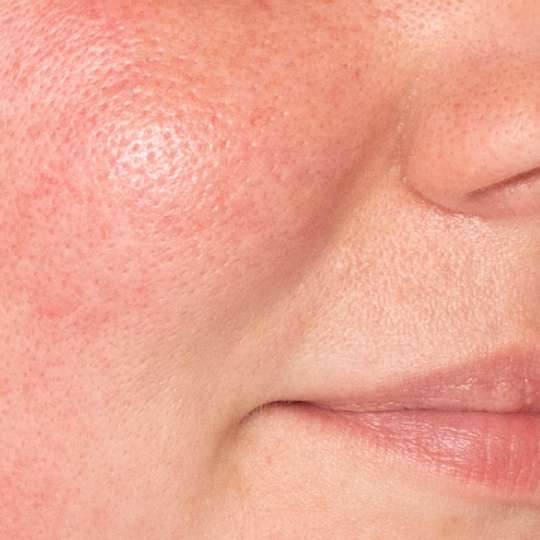

What is sensitive skin?
Sensitive skin is a blanket term, not a diagnosis, which means its meaning is somewhat up for interpretation. And this is where the confusion starts. Sensitivity can range from mild rashes and redness during the change in seasons to full-blown stinging and itching. Rosacea, eczema and psoriasis are also often put under the umbrella of sensitive skin, but while the recommended treatments can be similar, they are separate medical conditions.
The key signs of sensitive skin are:
-
Stinging
-
Burning
-
Itchiness
-
Redness
-
Tightness
-
Rashes
-
Feeling sore to the touch
If you have sensitive skin, you will probably have at least two of these symptoms. In most cases, they will be on-going gripes that you are consistently affected by, rather than something like occasional rashes during a stressful period. That’s the key difference between sensitive skin, and skin that gets itself into a pickle from time to time.
Causes of sensitive skin
There are a number of different factors that can cause sensitivity in the skin. These include, but are not limited to:
Genetics
Just as your parents' genes will determine your hair and eye colour, they also have a part to play in your skin. If they have sensitive skin, it’s more likely that you will too.
Age
As we age, levels of collagen and elastin deplete, and our skin also makes less lipids (the good fats that give our skin structure). Without these for support, it becomes thinner, and is therefore more likely to suffer sensitivity – even if it was previously pretty hardy. Think of it like your plump winter duvet compared to a lightweight summer one.
UV exposure
Some people are sensitive to the sun, with exposure to UV rays triggering redness, itching and rashes. This is different to prickly heat, which is caused by the skin becoming too hot, rather than sunlight.
Over-exposure to unsuitable products
If you continuously use products that are too strong or badly suited to your skin, your skin can become sensitised. This means that it can now no longer tolerate the same products or ingredients it once could, and will easily break into redness or rashes. Sensitised skin is different from skin that is genetically sensitive, or has become more sensitive with age.
How to care for sensitive skin
Finding a skincare routine for sensitive skin can feel like trying not to wake a sleeping baby. You tip-toe around it, worried that the slightest misstep onto a creaky floorboard could fuel a hissy fit. It’s touchy, but the right care can keep it happy.
Go back to basics
The skincare market might be awash with newly launched products, but that doesn’t mean they’re right for your sensitive skin. Don’t let the fear of missing out cause you to irritate your complexion, and stick instead to a pared-back routine made up of products designed for sensitive skin. Cleansing, moisturising and applying SPF are your non-negotiables here. Only once you have mastered these basics and got your skin into a place where it is happy and comfortable, could you start to consider incorporating serums or exfoliants. Even then, go slow, which brings us on to��…
Patch test first
Worried your new serum might not be well-received by your sensitive skin? Instead of slathering it all over your face, patch test first by applying to a small area. Then wait 48 hours to see how your skin reacts. If there’s no sign of irritation, you should be ok to use it on a larger area. Introduce new products slowly at first, using just twice a week, to allow your skin to get used to them. If your sensitive skin can’t tolerate potent actives like retinoids and alpha-hydroxy acids, look to less irritating options like peptides and poly-hydroxy acids instead.
Be consistent
Much like a tetchy toddler, sensitive skin likes routine. Stick to the same products as much as possible, and if you do want to change something, swap one product one at a time, instead of overhauling your entire regime at once. This will also help you to see which products are, or aren’t, working for your complexion. Mixing it up and straying from what your skin needs can have uncomfortable repercussions. Think of it like a cashmere jumper. You might normally pop it on a cold hand wash, but if you accidentally wash it at 60° just once, it will still shrink.
Restore the barrier
Our skin is the barrier which defends our body from the outside world. When it is compromised helpful things like moisture can escape, and external stressors, like pollution, can sneak in. In this scenario, skin is more likely to become angry and inflamed. If you have sensitive skin, the protective outer layer of skin tends to be thinner or compromised. We need to strengthen the skin’s barrier so it is better able to defend itself – think of a sturdy brick wall rather than a flimsy fence. While your skin might look smooth on the surface, it's actually made up of a number of cells, held together by lipids like ceramides. If the cells are bricks, then the lipids are the mortar. Keeping your skincare simple (that means no exfoliants or strong actives) and choosing a barrier cream with skin-like lipids will help keep it strong and sturdy. Doubling down on humectants like hyaluronic acid and glycerine, alongside soothing cica is a good idea too.
Care for the skin microbiome
Our skin is home to a colony of microscopic organisms (mainly bacteria) that are invisible to the naked eye. It sounds a little disturbing, we know, but these are friendly bacteria, much like the ones that keep our gut healthy, and work behind the scenes to keep our skin at its best. Over-cleansing (more than three times a day) or using harsh, stripping products can disrupt this thriving ecosystem, triggering sensitivity and discomfort in the process. Look instead for nourishing products containing prebiotics. These serve as food for the good bacteria, helping them to flourish.
Natural isn’t necessarily better
In recent years, there has been a shift towards more natural beauty products, in the belief that they are safer. The truth is that just because an ingredient is considered natural, that doesn’t mean it doesn’t carry the risk of irritation, in the same way synthetic ingredients are not guaranteed to cause problems. A good example of this is essential oils. They should only be used in diluted, low doses, but even then they can still cause irritation when applied to skin that is already compromised.
Steer clear of fragrance
It might make using your skincare a more sensory experience, but fragrance is one of the biggest irritants out there. Look out for products labelled as fragrance-free to stay on the safe side. If you’re unsure as to whether something has fragrance in it, the sniff test is your first port of call. You can also check the INCI list. Fragrance is most commonly listed as “parfum”. Remember, both synthetic and natural fragrances can annoy sensitive skin.
Read, watch and be inspired...



